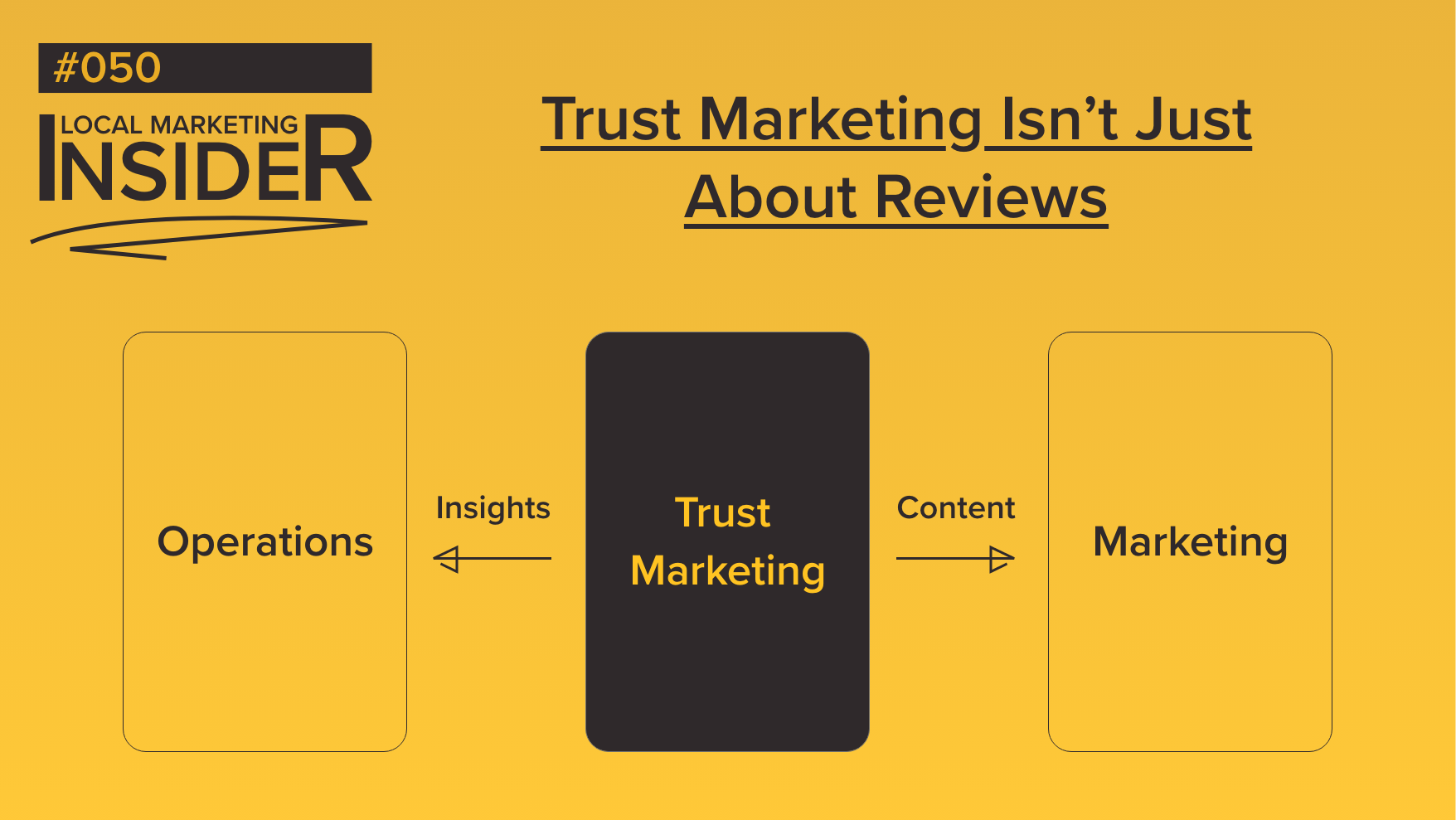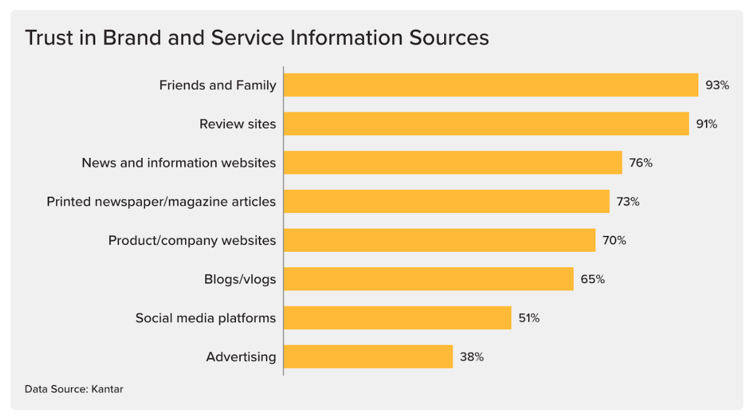Trust Marketing isn't just about reviews. Here are 3 key Trust Marketing concepts that go beyond mainstream thinking.

#1: Put the customer at the center of your messaging.
Traditional Marketing: brand controls the narrative
Trust Marketing: the brand communicates its narrative through the customer's words in the form of text and video reviews.
Slight difference. Massively different outcomes.
Take it from Jeff and Scott:
“Your brand is everything people say about you when you’re not in the room.” Jeff Bezos
“A brand is no longer what we tell consumers it is - it’s what consumers tell each other it is.” Scott Cook, Co-Founder, Intuit
Trust leaders today understand the customer is your most trustworthy marketing asset.

Think about this: 93% of consumers trust friends and family, 91% trust review sites, and just 38% trust advertising. And guess where all of the marketing dollars are spent…
Marketing spend should probably be flipped on its head.
Putting the customer at the center drives trust, persuasion, and, as a result, conversion.
And don’t forget, in trust marketing, your customers are creating most of the content for you, and as a result marketing teams can focus more time on packaging and distributing that content effectively.
This gets me to my next point about team structure.
#2: Frontline, on-site staff should not be tasked with managing your trust marketing strategy.
Historically, review strategy execution has been handled in-house, separately at each location, by on-site staff who are also responsible for many other things.
This approach has a handful of weaknesses.
In many industries, the on-site staff has become increasingly valuable, and expensive.
Often, especially given that trust marketing and reputation management are relatively new marketing strategies, on-site staff are not reputation experts.
They’re customer service experts. Best when interacting with customers face-to-face.
Centralizing your strategy, such that a single manager (or small team) has oversight of the entire group’s reputation performance will create the most efficient system, but you’ll need software and automation to help centralize your review data.
A Director of Centralization in the property management industry communicates it like this, “In my role, I am reading the crystal ball of the data. I am taking in review and survey data and mapping it out to reveal trends and understand how experiences vary along the customer journey. I am then quarterbacking that information and passing it to the relevant departments because the real challenge is making sure we are doing something with the feedback we receive.”
Aggregated customer review data is a great operational tool, which brings me to point #3.
#3: Trust marketing is owned by the marketing team, but is a tool for both marketing and operations.
Trust marketing and reviews are widely understood as falling into marketing’s domain (hence the name of this newsletter), but we like to think of Trust Marketing as its own function, living between marketing and operations, servicing both departments in different ways.
How Trust Marketing supports marketing:
How Trust Marketing supports operations:
Organizations expecting on-site staff to both manage the day-to-day rigor of managing a review program and simultaneously take action on the feedback are approaching the problem suboptimally.
And to steal Hubspot’s terminology, it creates a review flywheel, creating better customer experiences that encourage more reviews which generates more operational feedback and gives onsite teams more insights on improvement opportunities.
What other marketing strategy has such clear operational benefits fully baked in? I’m not sure there is anything like it.
Key Takeaways
#1: Put the customer at the center of your messaging.
Trust leaders today understand that customer feedback is the most trustworthy marketing asset and should be utilized to its fullest potential, operating as a central brand messenger.
#2: Front-line staff should not be tasked with managing reviews.
Centralized management of review generation, review response and performance analysis mean behind-the-scenes operators can identify trending issues and front-line staff can put 100% of their focus on acting upon and resolving trending issues.
#3: Trust Marketing powers both marketing and operations.
Trust Marketing powers an always-on feedback machine, full of customer insights identifying ever-changing opportunities for improvement.
Around this time last year, I wrote a 5-part series on Trust Marketing. Want a refresh or new to LMI? Still a handful of my favorite articles, you can find them here
LMI #022: What is Trust Marketing?
LMI #20: Why is social proof so persuasive?
LMI #19: What is Distributed Trust?
LMI #18: What is Trust in the Digital Age?
We made it to issue #50! Thank you to our early readers that have been following along for the past two years. To LMI’s newer readers - welcome! You’re among the nearly 7,000 local marketers exploring different ideas and frameworks related to local marketing, reputation management, reviews and trust.
To get LMI in your inbox 2x/month, subscribe. ✌️ from Vermont.
See you in 2 weeks, Jake - Marketing @Widewail
I’m the Director of Marketing here at Widewail, as well as a husband and new dad outside the office. I'm in Vermont by way of Boston, where I grew the CarGurus YouTube channel from 0 to 100k subscribers. I love the outdoors and hate to be hot, so I’m doing just fine in the arctic Vermont we call home. Fun fact: I met my wife on the shuttle bus at Baltimore airport. Thanks for reading Widewail’s content!
Bite-sized, to-the-point, trend-driven local marketing stories and tactics.
U3GM Blog Post Comments